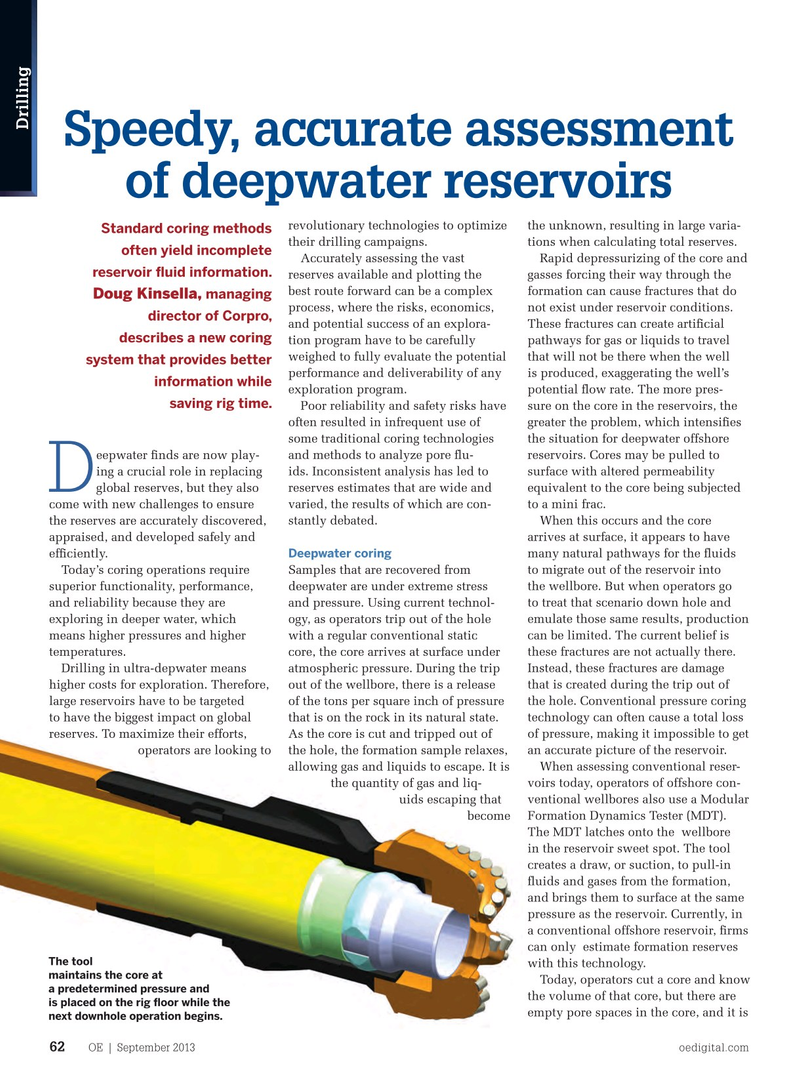
Page 60: of Offshore Engineer Magazine (Sep/Oct 2013)
Read this page in Pdf, Flash or Html5 edition of Sep/Oct 2013 Offshore Engineer Magazine
Drilling
Speedy, accurate assessment of deepwater reservoirs revolutionary technologies to optimize the unknown, resulting in large varia-
Standard coring methods their drilling campaigns. tions when calculating total reserves.
often yield incomplete
Accurately assessing the vast Rapid depressurizing of the core and reservoir fuid information. reserves available and plotting the gasses forcing their way through the best route forward can be a complex formation can cause fractures that do
Doug Kinsella, managing process, where the risks, economics, not exist under reservoir conditions. director of Corpro, and potential success of an explora- These fractures can create artifcial describes a new coring tion program have to be carefully pathways for gas or liquids to travel weighed to fully evaluate the potential that will not be there when the well system that provides better performance and deliverability of any is produced, exaggerating the well’s information while exploration program. potential fow rate. The more pres- saving rig time.
Poor reliability and safety risks have sure on the core in the reservoirs, the often resulted in infrequent use of greater the problem, which intensifes some traditional coring technologies the situation for deepwater offshore eepwater fnds are now play- and methods to analyze pore fu- reservoirs. Cores may be pulled to ing a crucial role in replacing ids. Inconsistent analysis has led to surface with altered permeability global reserves, but they also reserves estimates that are wide and equivalent to the core being subjected
D come with new challenges to ensure varied, the results of which are con- to a mini frac.
the reserves are accurately discovered, stantly debated. When this occurs and the core appraised, and developed safely and arrives at surface, it appears to have effciently. many natural pathways for the fuids
Deepwater coring
Today’s coring operations require Samples that are recovered from to migrate out of the reservoir into superior functionality, performance, deepwater are under extreme stress the wellbore. But when operators go and reliability because they are and pressure. Using current technol- to treat that scenario down hole and exploring in deeper water, which ogy, as operators trip out of the hole emulate those same results, production means higher pressures and higher with a regular conventional static can be limited. The current belief is temperatures. core, the core arrives at surface under these fractures are not actually there.
Drilling in ultra-depwater means atmospheric pressure. During the trip Instead, these fractures are damage higher costs for exploration. Therefore, out of the wellbore, there is a release that is created during the trip out of large reservoirs have to be targeted of the tons per square inch of pressure the hole. Conventional pressure coring to have the biggest impact on global that is on the rock in its natural state. technology can often cause a total loss reserves. To maximize their efforts, As the core is cut and tripped out of of pressure, making it impossible to get operators are looking to the hole, the formation sample relaxes, an accurate picture of the reservoir. allowing gas and liquids to escape. It is When assessing conventional reser- the quantity of gas and liq- voirs today, operators of offshore con- uids escaping that ventional wellbores also use a Modular become Formation Dynamics Tester (MDT).
The MDT latches onto the wellbore in the reservoir sweet spot. The tool creates a draw, or suction, to pull-in fuids and gases from the formation, and brings them to surface at the same pressure as the reservoir. Currently, in a conventional offshore reservoir, frms can only estimate formation reserves
The tool with this technology.
maintains the core at
Today, operators cut a core and know a predetermined pressure and the volume of that core, but there are is placed on the rig foor while the empty pore spaces in the core, and it is next downhole operation begins.
OE | September 2013 oedigital.com 62 062_OE0913_D&C Corpro.indd 62 8/18/13 11:24 PM

 59
59

 61
61